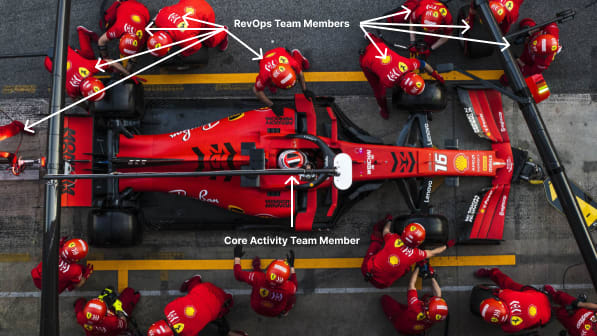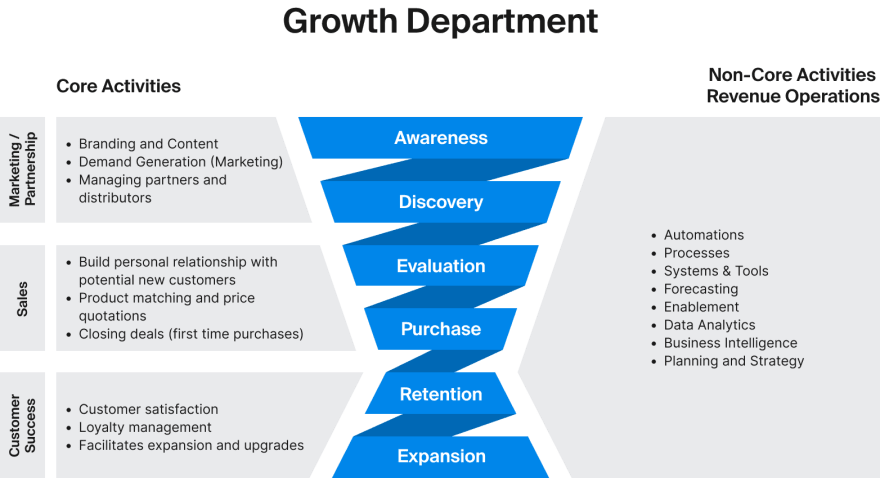The success of the revenue operations department at FINN, and elsewhere, can be defined with three simple words: efficiency.
This article will help you to get acquainted with foundational knowledge about Revenue Operations. If you have vast experience in the field already, you can jump right into the section on Revenue Operations at FINN.
Let’s go!
Revenue Operations: A brief story of efficiency 🚀
Revenue operations, often shortened as RevOps, is the department that consolidates all the non-core activities of the critical growth departments covering the full customer life cycle, which in most instances are marketing, partnerships, sales and customer success.
If you allow me the automobile analogy, team members working in the core growth departments are the drivers behind the steering wheel of a racing car. They are in the hot seat and control the wheel, they change gears and decide when to push for an overtake. Races cannot be won without them. RevOps team members are a good chunk of everyone else in the racing team: we buy and maintain the motor, make sure that the tires used are in optimal condition and get changed at the right time, we provide critical intel and insights, and care for the needs of our drivers. While in business, the ratio of drivers to other team members is upended, but the comparison of roles holds.
 A Formula One car getting its tires changed during a race. The pilot represents the core activity team members, while most of the others represent RevOps team members.
A Formula One car getting its tires changed during a race. The pilot represents the core activity team members, while most of the others represent RevOps team members.
The concept of centralizing non-core growth operations and disciplines under a single roof to deliver greater efficiency and accountability is well established in top tech companies, as well as in firms with a large share of revenue coming from B2B, as a way to sustain growth and accelerate go-to-market (GTM) strategies.
Here is a graphical way to describe the distribution of duties between departments across the whole sales funnel:
 Core and non-core activities across the growth funnel
Core and non-core activities across the growth funnel
💶 Show me the money
In a recent deep dive Forbes concluded:
“Research shows that businesses that deploy revenue operations can generate significantly more revenue and profits by better managing, measuring, and monetizing their revenue generating commercial assets and the growing operations that support front line sellers”
Multiple benefits are powering the move towards centralizing the operational structure of growth teams. The most impactful ones for improving performance are:
- Process powers, which refers to delivering higher efficiency out of tools and people across the whole funnel. The impact of this competitive advantage is best explained by Hamilton Helmer in 7 Powers: The Foundations of Business Strategy, where Process Powers are highlighted as one of the most complicated but durable strategic advantages a company can develop to guarantee persistent differential returns.
- Strategic alignment derived from a vast simplification of metrics, reporting, systems integrations and complete life cycle growth strategies.
- Speed to act. High levels of automation, with fully integrated or in-house built tools, multiply the impact on investments, such as improving LTV/CAC (lifetime value of a single account/cost of acquiring such account) returns.
🏰 Key pillars
Now that we know the basis of RevOps, let’s focus on the four key pillars that will drive the success of the department: operations optimization; tools and systems; data, insights and strategy; and enablement and alignment.
Operations optimization
Focused on managing resources, defining and improving processes, as well as having a never-ending thirst for automations—the operations optimization team within RevOps is the secret weapon of well-functioning growth teams.
Smooth and automated processes allow for faster sales cycles, lower churn rates and greater win rates, to name a few. Those benefits, combined with the superior efficiency of sellers, compound each other, allowing the company to expand organically at a faster pace.
Operations teams also take great care in improving and constantly adding self-service features for the end customer, which increases customer satisfaction and sales.
Tools and systems
Today, there is no shortage of advanced systems which companies can opt for when planning their tech stack. The list of companies serving the B2B space, often referred to as SaaS, is estimated to be between 25,000 to 30,000, with the vast majority being launched in just the last five years. If someone decided to spend ten minutes evaluating each of them, it would take that person 208 days to complete such a review, with no breaks in between—not even a small siesta.
On top of that, there is always the debate between build or buy.
The work doesn’t end once the tech stack has been decided on or built. Not only do options need to be accessed constantly, but even the best tech stack would be dysfunctional with poor integrations.
The tools team is responsible for all the technology used across the whole revenue funnel, constantly evaluating the tech stack, planning and procuring new systems, integrating them, acting as a system admin, and managing product development of tools made in-house.
Data, insights and strategy
Data is the new oil—that much is well known and you didn’t read it here for the first time. However, what it takes to move that oil from the underground reserve to the cash machine is not so well known.
Data accuracy, velocity, and visibility drive selling effectiveness. When maximized by data democratization, intuitive visualization and strong actionable insights, a productive data team can enable all other team members to positively steer the performance of growth teams.
Account and pipeline health is often described as a top driver of the growth teams’ performance. Data teams have an overweight responsibility for such Key Performance Indicators (KPIs), as they own the creation of smart systems that algorithmically optimize for the best possible scenarios, such as personalized pricing for the right customer, at the right time. Another example is developing a Sales Pipelines Forecast, which allows front-sellers to optimize their time with greater Return On Investment (ROI) potential ahead.
Enablement and alignment
Enabling is empowering the front-line team members to be self-sufficient and able to operate at maximum speed and precision—tasks often labelled as “arming the rebels”.
The foundational block in enabling talent is designing efficient onboarding, development programs, and continuous coaching. Proper documentation, training materials, and defining efficient ways to transfer information are also key missions of this pillar. This classification of enabling responsibilities is often shared between core-activities management, the people team, and RevOps, the involvement of each team is something that differs per company.
Alternatively, other items that can enable teams to perform with efficacy belong to a different classification than the prior ones. Tasks such as drafting the team structures, pricing and promotions, defining incentive frameworks that reward the highest impact behaviours, and go-to-market strategies for new markets are tasks supervised by this RevOps pillar.
Revenue Operations at FINN 🤩
 Portfolio of cars from FINN
Portfolio of cars from FINN
At FINN, the RevOps team started to take shape in late 2021 and has greatly contributed to enabling the growth of the B2B division. While we already cover most of the previously discussed items, we have headroom left to keep adding areas of responsibility.
Since the creation of the RevOps department, FINN B2B ARR (Annual Recurring Revenue) has grown by more than 510%, taking FINN to hit the €110M ARR milestone. While the growth trajectory of FINN has always been up-to-the-right, and no single team is solely responsible for such achievement, the RevOps department has played an essential role in providing the rails that allowed for such growth to happen sustainably.
💡 Highlighted projects
RevOps has delivered several critical projects for FINN, some of which belong in areas such as strategy or go-to-market. However, such topics are complex to explain and require a considerable amount of context, plus the juicier details are highly sensitive and therefore can’t be published. But fear not, there is still a sizable share of projects that can be shared externally, some examples of which are the following.
Deals streamlining automations [Operations Optimization]
A big-time (and thus efficiency) loss for sales teams can be derived from duplications of deals from the same account. This issue is of such prevalence and persistence that a whole industry of service providers exists to tackle such concern. We know, we used to use one of those. However, we ended up taking another approach: we built our own duplicate management system in-house, using low-code automation tools. New leads get filtered through it automatically and compared against the tens of thousands of existing companies and leads in our customer relationship management (CRM) database. This system recognizes potential duplicates with 99% accuracy, so no time gets wasted with two people reaching out to the same company.
Since go-live, the duplicate check has saved our sales teams countless hours, as well as reduced our SaaS expenses.
Offer tool [Tools and Systems]
The Offer Tool describes a collection of in-house-made apps and services developed by our software engineers. Together, they enable sales and customer success representatives to check inventory and prices, and ultimately generate tailor-made offers for our clients. The tool’s backend is built in Python and deployed via Serverless to support our continued hyper-growth. The front end is built via Retool, allowing fast and agile development.
The Offer Tool alone facilitates close to 50% of FINN’s subscription revenue, which makes it one of FINN’s most important in-house-built tools. This is also reflected by the fact that more than a third of the company’s Retool pageviews are accounted for by the Offer Tool.
Before the Offer Tool was developed, sales and customer success representatives would spend 30 minutes searching for available cars, reserving them, and creating the actual offer document in multiple different SaaS tools. Thanks to the Offer Tools all of these actions can now be done in one tool, which reduced the average time to create an offer to just 3 minutes.
Demand prediction models [Data]
Being able to predict demand with high precision is a competitive advantage for any company. For some of those companies, it is also a matter of survival. Our data team is the key driver of our short-term forecast, which is utilized to determine demand in the next 90 days to allocate resources and flex strategies accordingly. The data team also does our long-range forecasting, which is used to plan car purchases for the future years—which in our business is a make-or-break turning point.
To deliver the most accurate predictions, we use a machine learning model in Google BigQuery, known as ARIMA, which combines external data with both supply and demand internal data. The accuracy of the model is north of 90%, and it’s the critical input that drives our car purchases plan.
Single-click account intelligence [Enablement]
Cold outreach effectiveness can define top-performing sales teams. Knowing who could be a potential new customer and when and how to best reach them are the foundational steps of cold calling and other outbound sales initiatives. To add accuracy and speed to these processes, we facilitated the data and technology that allows our sales representatives to obtain contact details and job titles of relevant employees for all our prospecting accounts directly into our CRM, in just a single click. On top of that, we added a conversion prediction model for all our deals, allowing us to easily prioritize sales tasks for accounts with the greatest potential.
Such a combination of convenient information and automatic prioritization has led to an increase in the effectiveness of our sales, increasing our new account penetration by over 15%.
🐐 Talent Spotlight: Dominik Fübi
 Dominik Fübi - RevOps Mastermind
Dominik Fübi - RevOps Mastermind
Let’s meet one of our RevOps masterminds, Dominik Fübi. Dominik:
“The beauty about RevOps at FINN lies in the fact that even as a single individual you can impact the whole growth department and influence every team member to be more efficient. As a result, I can safely say that we have positively impacted how every growth team operates and accelerated our target achievements.
“I joined FINN over 1.5 years ago. As I look back today, it is difficult to shortlist the projects I have actively participated in, if not led, that moved the needle most for the department. To name two that come to mind: we built a complete invoicing, billing and dunning system from scratch with low-code automation tools over the span of multiple months; and we deployed a new calling solution and built all supplementary actions and reporting in-house. What I enjoyed in these projects is the ability to build things from the ground up and push them from start to finish, never knowing what to expect, working with new systems and negotiating with external providers.
“To take it a step further, we have also delivered cross-departmental projects, outside our growth units, that affect a large share of employees at our company, such as further democratizing data access by implementing drill-down features in our reporting tool. Furthermore, we introduce new tools and processes that then get adapted by other departments and are used as blueprints, both in Europe and in the USA.
“As a closing thought, a personal highlight of mine would be the large set of smaller, quality of life changes that we create and maintain on a daily basis. Such small changes have no major importance when singled out, however, on aggregate they are the oil that keeps our engine firing on all cylinders. We really help people in all areas not only to make their job easier and more efficient, but we also actively listen to their feedback and ideas to cater our infrastructure to their needs when possible. Onwards!”
Always recruiting 💫
The work of RevOps has no end since improvements are always to be chased. If you have experience in revenue operations and you are interested in joining the company building the most popular car subscription platform in Germany and the USA, please contact us directly.
Alternatively, if you have no experience, but are highly interested in revenue operations at FINN, reach out if some of the following traits apply to you:
- You love finding out all details about how things work
- You are often upset about redundancy and inefficiencies
- You know how to manipulate data to deliver value to other people (who have no interest in manipulating data)
- You are tech-savvy and have a passion for building things
- You suffer from extreme accountability
- You see problems as games to beat and often thrive to the top of the leaderboard
- You have an excellent track record selling and marketing products
For those of you that read until the end, I have three simple words for you: Thank you!
P.S. I am terrible at math.
❤️ Contributors
Dominik Fübi | Christophe Tambourgi | Iryna Lysenko | Christian Poetter | Jan Hansen | Charleen Piecek | Chris Onrust Meyns | Lucas Cantos | Shpat Cheliku | FINN
🔍 References and worthier articles about Revenue Operations
- HELMER, Hamilton, 7 Powers: The Foundations of Business Strategies
- DIORIO, Stephen, What is Revenue Operations and How Does It Create Value? in Forbes
- MaRS Startup Toolkit, Getting started with Revenue Operations (RevOps)
- FABBRI, Federico, and Basir MUSTAGHNI, Marina NEKRASOVA, Tom MATUSZCZYK, and Matt WARD, Revving Up Go-to-Market Operations in B2B, on BCG
- Revenue Operations: Everything You Need to Know, on Chili Piper
- LOWE, Michael, The Rise of Revenue Operations - What is RevOps?, on Clari
- GREY, Calum, Revenue operations: what is it and why do you need RevOps?, on Revenue Grid
- HOWARTH, Josh, How Many SaaS Companies Are There? (2022)
- How Many SaaS Companies Are There in the World, on Ascendix
- HUMMEL, Chris, What is Revenue Operations and How Does it Create Value?, on Revenue Enablement Institute
This article was written by Alfonso Comino.
